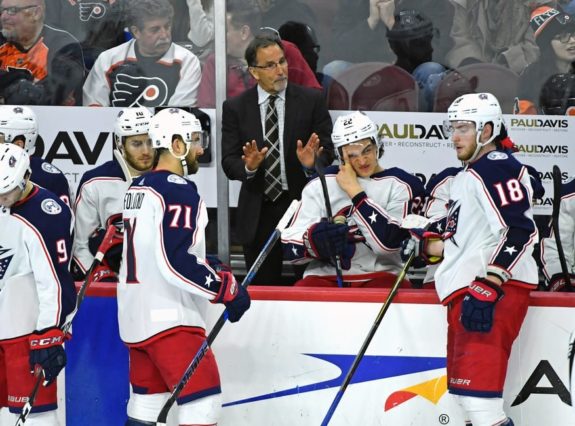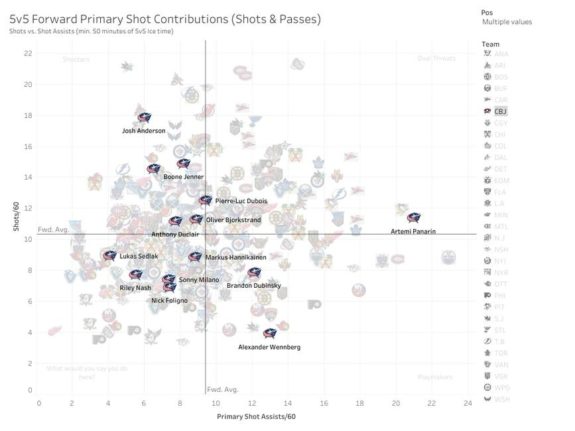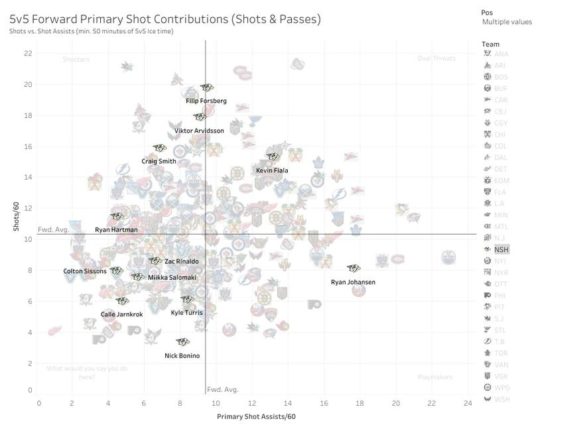Over the last few weeks, I have been writing a series of trade deadline targets for the Nashville Predators in advance of the 2019 Trade Deadline on Feb. 25. I’ve covered the Ottawa Senators, New York Rangers, Philadelphia Flyers and Florida Panthers. Today, I wrap up the series by looking at the last deadline target, the Columbus Blue Jackets.
Related: Predators’ Trade Deadline Strategies
Like the Panthers, the Blue Jackets have struggled to find consistent success as a franchise, although their mediocrity hasn’t lasted as long as Florida’s. In 17 seasons, the Blue Jackets have qualified for the postseason four times, but have yet to advance past the first round. By comparison, they’ve had eight last-place finishes and nine head coaches.
Although it has taken a long time to develop into a consistent contender, that’s where they find themselves with two straight playoff appearances. That includes being a Lars Eller double-overtime goal away from going up 3-0 on the Washington Capitals in the first round of last season’s playoffs. Being so close to winning a series, in conjunction with possessing a talented core, led many to view them as potential Metropolitan Division winners in 2018-19.
Related: THW’s Top-10 Trade Deadline Watchlist
The 2018-19 Blue Jackets
They were in a position to capture the franchise’s first division title for a portion of the season, but have backslid in recent months. At the time of writing this, they have a 33-22-3 record with 69 points and find themselves fourth in the division and eighth in the conference. They are two points back of the Pittsburgh Penguins for third in the division and have a one-point cushion for the last playoff spot.

They are 10th in the league in goals per-game, 15th in goals allowed per-game, 28th on the power play, fifth on the penalty kill and 22nd in save percentage. Their blue line has been great, while their offense has been productive in the top-six, but lacks depth. What’s been holding the team back is their goaltending, a position group that should have been trustworthy. The group is led by Sergei Bobrovsky who, in 42 games, has a 24-18-1 record with a .904 save percentage, a 2.89 goals-against average and a minus-4.96 goals saved above average.
That puts the Blue Jackets in an awkward position. They’re good enough to reach the postseason, but aren’t a serious Stanley Cup contender. Most teams in their position would be buyers at the trade deadline to bolster their roster. However, the Blue Jackets likely won’t be buyers due to the contract situations of Bobrovsky and Artemi Panarin. Both are unrestricted free agents this summer and neither appear interested in re-signing with Columbus.
As a result, the team finds itself with a decision to make. They can keep both at the trade deadline and view them as internal playoff rentals, or they could deal both players for young NHL players and picks or prospects, although Bobrovsky has a no-movement clause that would need waived before a trade is made. Columbus could then either flip those assets for other proven NHL-ers or hold onto them and add to a talented core.
To me, it makes sense to trade both Bobrovsky and Panarin, although Bobrovsky does control what happens to him. Trading both is the only way to ensure having a competitive roster in the immediate future. If the Blue Jackets were more of a serious contender this season, it’d be a different story, but they’re not. Moving Panarin would yield them an asset package that would help them now and in the future, and many teams are interested in him, including the Predators.

Artemi Panarin
Panarin is a 27-year-old right-shot winger with a $6 million cap hit.
Elite Offensive Talent
In 56 games this season, Panarin has 24 goals and 67 points, leading the Blue Jackets in the latter category. He is shooting a career-high 16.3 percent while skating 20:08 per-game. He is averaging .43 goals-per-game and 1.20 points-per-game, both career highs.
At five-on-five, he is averaging 16:11 per-game, .99 goals-per-60 (G/60) and 3.04 points-per-60 (P/60) while shooting 14.4 percent, with all but time on ice as career highs. His points-per-60 have also increased each of his four seasons in the NHL. Meanwhile, he is averaging career lows of 6.29 individual scoring chances per-60 (iSCF/60) and 2.05 individual high-danger chances per-60 (iHDCF/60).
He has played this season on Columbus’ top line, mostly with Atkinson and Dubois with 585 shared five-on-five minutes. As would be expected from a line that includes Panarin, the line has dominant metrics with their shots for (SF%), goals for (GF%), scoring chances for (SCF%) and high-danger chances for (HDCF%) percentages all at or above 55. However, in the 108 minutes without Panarin, Atkinson and Dubois’ metrics drop in a significant manner. This means Panarin drives that line, making him one of a few wingers in the league who can do so.
| SF% | GF% | SCF% | HDCF% | |
| Panarin with Atkinson and Dubois | 55.0 | 57.0 | 55.9 | 55.4 |
| Atkinson and Dubois without Panarin | 35.5 | 41.7 | 39.6 | 40.9 |
As would be expected from someone with his skillset, Panarin excels on the man advantage. He is skating 3:01 per-game on the power play and is averaging 2.16 G/60, a career high, 5.04 P/60, 10.4 iSCF/60 and 1.44 iHDCF/60 while shooting 16.7 percent. He has been on the ice for 17, or 65.3 percent, of Columbus’ 26 power-play goals. He doesn’t kill penalties.
What Would He Bring to the Predators?
It’s pretty obvious what Panarin would bring to the Predators, or any team for that matter. He’s an elite winger who excels at both scoring and playmaking. He’s a two-time 30-goal scorer but has developed into one of the game’s premier passers since joining the Blue Jackets two seasons ago. The Predators, along with the majority of teams, don’t have a player like him.
Filip Forsberg is great in all facets, Ryan Johansen is an excellent puck distributor and Viktor Arvidsson is the team’s best goal scorer, however, none of them possess the package of skills that Panarin does. Using Corey Sznajder’s five-on-five passing data, Panarin is considered a dual threat player, averaging 21 primary assists per-60 (A1/60) and 11.4 shots per-60 (S/60).

Meanwhile, the NHL average is 10.3 A1/60 for forwards and 9.4 A1/60 for all players. The Predator with the highest primary assists per-60 rate is Johansen at 17.7, while he attempts 8.1 S/60. But there’s a lot more to Panarin than his ability to generate scoring chances for himself and others. He’s also a dynamic producer.

Among Predators with 100 minutes of ice time this season, Panarin’s 1.28 G/60 and 3.56 P/60 in all situations would rank third and first, respectively, on the team. At five-on-five, his .99 G/60 and 3.04 P/60 would rank third and second, respectively, while his 6.29 iSCF/60 and 2.05 iHDCF/60 would rank 10th and 13th, respectively. On the power play, and among Predators with at least 50 minutes on the man advantage, his 2.16 G/60 and 5.04 P/60 would be first, his 13.0 S/60 and 16.7 shooting percentage would be third and his 10.4 iSCF/60 and 1.44 iHDCF/60 would rank fifth and 10th, respectively.
This reveals the underlying problem in Nashville’s offense this season: they generate plenty of scoring chances, but don’t capitalize on those chances. Panarin is the type of player who generates and capitalizes on scoring chances, and would immediately become the Predators’ biggest offensive threat, if added.
A few more pieces of information to show how impactful he is. At five-on-five this season, the Blue Jackets are a plus-25 percent threat to score when Panarin is on the ice. Without him, they are a minus-four percent threat. On the power play, they are a minus-six percent with him deployed, not a great rate but still a far cry better than the minus-41 percent threat they are without him.
Additionally, Panarin’s 15.2 goals above replacement (GAR) and 2.6 wins above replacement (WAR), the number of goals and wins he contributes relative to a replacement-level player, are both tops on the Blue Jackets. By comparison, Colton Sissons leads Nashville forwards with 7.1 GAR and he and Nick Bonino lead their forwards in WAR with 1.2. Among all Predators skaters, Ryan Ellis leads the team in both categories, with 10.4 GAR and 1.8 WAR. As you can see, acquiring Panarin would take the Predators from Stanley Cup contender to one of the Cup favorites.

What Would He Cost?
As one would assume, acquiring Panarin won’t be cheap. He’s at worst a top-15 player in the league, and perhaps top-10. He is a playoff rental for most teams, with the Predators likely among them. Yet, at the same time, he’s not a typical rental given his value and because Columbus isn’t entirely sold on the idea of moving him. Because of those aspects, it will require a hefty package to land him.
As previously mentioned, the Blue Jackets will either be looking for an asset package that includes a young, controllable NHL player as the centerpiece in addition to picks and prospects, or one that has prospects and picks of high value that they can further flip to add to their NHL roster. Regardless, the idea is to not strip down their NHL roster, but instead remain competitive.
For the Predators, the first asset package revolves around Kevin Fiala, their 22-year-old winger who’s a former first-round pick and whose entry-level contract (ELC) expires at season’s end. That means he’ll have four more seasons before becoming an unrestricted free agent. It would also take a first-round pick, and perhaps a second-rounder, in addition to a prospect like Yakov Trenin, Anthony Richard, Alexandre Carrier or Frédéric Allard, all NHL-ready, but don’t have the upside of Eeli Tolvanen or Dante Fabbro.

The second asset package would have to involve one of Nashville’s top prospects, Fabbro or Tolvanen. Fabbro has more value as a right-shot defenseman, but is also riskier given he hasn’t signed his ELC. On top of one of them, they’d still have to include a first, and likely a second-round draft pick.
Will the Trade Happen?
Given the number of teams rumored to be interested in Panarin (the Boston Bruins, New York Islanders and Florida Panthers are among them), it seems unlikely the Predators emerge from the trade deadline with him. If a bidding war ensues, and one probably will, the Predators have less valuable NHL-ready players and prospects than any of the three teams mentioned above do.
General manager David Poile could offer Fiala, Fabbro or Tolvanen and draft picks, a nice package, but it’s nothing compared to what the Panthers could offer with Mike Hoffman or Jonathan Huberdeau as the trade’s centerpiece. That means Poile would have to nearly strip the farm system bare to acquire a player who is likely nothing more than a rental. So rather than asking ‘will the trade happen?,’ perhaps the better question is ‘should the trade happen?’
My simple answer to that question is ‘no.’ That’s because paying a premium for a player they would likely only have for the remainder of the regular season and the playoffs simply isn’t worth it. If the Predators were already a clear favorite to get through the Western Conference and Panarin was an addition who could push the team over the edge, then it’d be something to seriously consider.
However, they’re not. Right now, the team has a great top line but aren’t getting enough depth scoring to be a real threat. Yes, Panarin would address their power-play woes, but those issues would reappear once he departed via free agency. Instead, the Predators need to add to their long-term core before adding such a big playoff rental. That’s why players like Matt Duchene and Mark Stone, both players who are likely to sign extensions with their acquiring team if they are both dealt, make more sense for Nashville.

That being said, Panarin is an elite hockey player and improves any team he’s added to. There’s also the reality that Poile is a gunslinger and isn’t afraid to make big trades, so it wouldn’t be surprising if the Predators do land Panarin, I just think it would be a mistake. Do you think the Predators should seriously consider adding Panarin? Let me know in the comments below.
*All stats came from Hockey-Reference, Natural Stat Trick and Evolving-Hockey